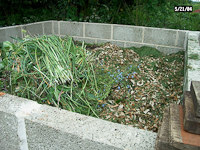 That ratio is a nice number but
how in the heck to we achieve it in our backyard compost bin? Do
we weigh everything we add in terms of brown and green? That
would be a very time consuming process for most of us.
That ratio is a nice number but
how in the heck to we achieve it in our backyard compost bin? Do
we weigh everything we add in terms of brown and green? That
would be a very time consuming process for most of us.
Actually, keeping the right
balance of nitrogen and carbon is part of the "Art" of
composting. It really boils down to your observing the pile and
making adjustments as necessary. But, how do you do that?
Generally, if the pile has a good
C:N ratio, it will be warm with a temperature at least in the 80
to 90 degree F. range. There will be no disagreeable odors to
the pile either.
So, here are some guidelines for
when to make adjustments to the carbon or nitrogen side of the
equation:
-
Pile
has Odors - A noticeable odor, especially of ammonia,
is an indication that too much nitrogen (green) is present.
This is a time to add a high carbon material such as
sawdust, brown leaves, etc.
-
Pile
has No Heat - This is a sign that the microorganisms
are not working very yard. Often this calls for addition of
more nitrogen and, perhaps, moisture.



